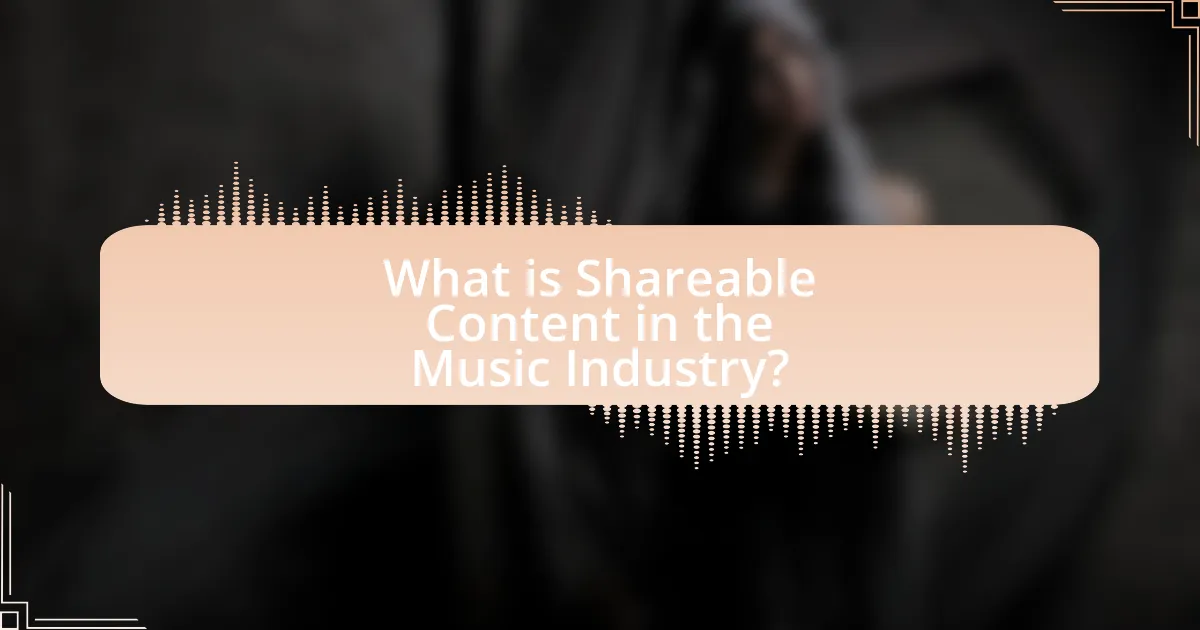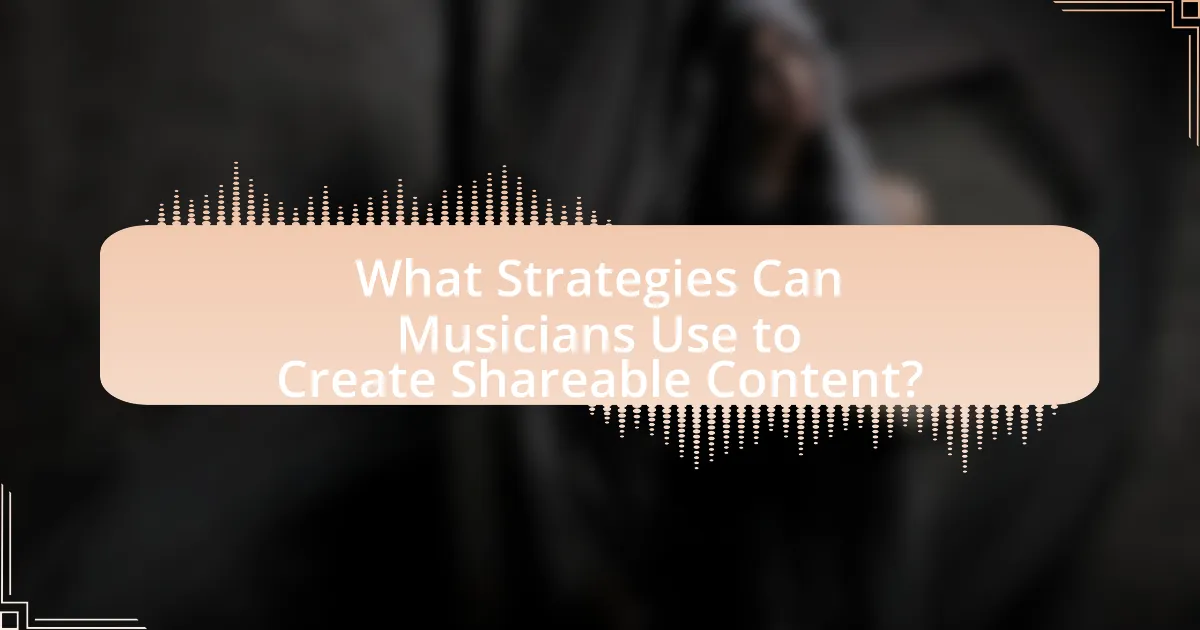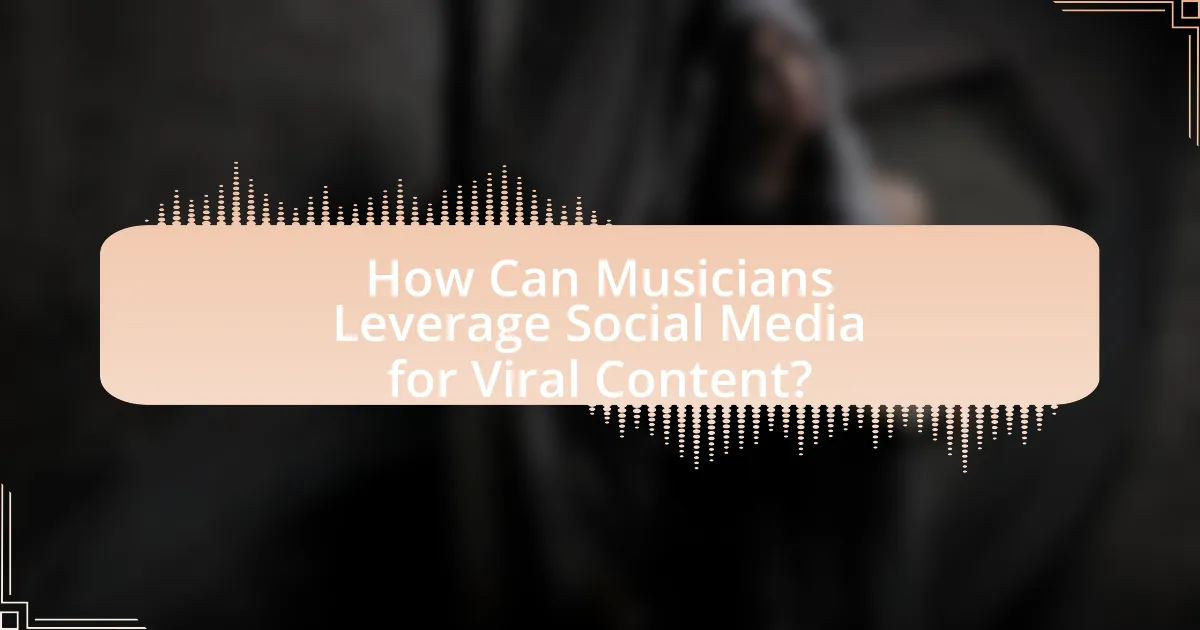Creating shareable content in the music industry is essential for artists seeking to enhance their visibility and engagement. This article explores the concept of shareable content, including types such as music videos, memes, and behind-the-scenes footage, and examines how emotional engagement influences sharing behavior. It highlights the importance of going viral, the benefits of collaborations, and effective strategies for leveraging social media platforms to maximize reach. Additionally, the article addresses common pitfalls to avoid and offers practical tips for producing high-quality, authentic content that resonates with audiences, ultimately driving increased revenue and fan engagement.

What is Shareable Content in the Music Industry?
Shareable content in the music industry refers to any digital material that is designed to be easily distributed and engaged with across social media platforms and other online channels. This type of content often includes music videos, memes, behind-the-scenes footage, artist interviews, and interactive posts that resonate with audiences, encouraging them to share with their networks. According to a study by the Pew Research Center, 72% of teenagers use Instagram, making it a prime platform for sharing music-related content, which can significantly enhance an artist’s visibility and reach.
How does shareable content impact an artist’s visibility?
Shareable content significantly enhances an artist’s visibility by increasing the likelihood of their work being disseminated across various platforms. When content is designed to be engaging and easily shareable, it encourages fans and followers to distribute it within their networks, thereby reaching a broader audience. For instance, a study by BuzzSumo found that content with strong emotional appeal is shared 2.5 times more than other types, illustrating how impactful shareable content can be in amplifying an artist’s reach. This increased sharing leads to higher engagement rates, more followers, and ultimately greater recognition in the music industry.
What types of content are considered shareable in music?
Shareable content in music includes music videos, live performances, behind-the-scenes footage, memes, and user-generated content. Music videos often go viral due to their visual appeal and storytelling, with platforms like YouTube reporting billions of views for popular releases. Live performances capture the energy of concerts, enticing fans to share their experiences. Behind-the-scenes footage provides an intimate look at artists, fostering a deeper connection with audiences. Memes related to songs or artists leverage humor and relatability, increasing shareability on social media. User-generated content, such as covers or dance challenges, encourages fan participation and expands reach, exemplified by trends like TikTok challenges that have propelled songs to viral status.
How does audience engagement influence shareability?
Audience engagement significantly enhances shareability by fostering emotional connections and encouraging active participation. When audiences interact with content—through likes, comments, or shares—they create a sense of community and investment, which motivates them to share the content with their networks. Research indicates that content with higher engagement rates, such as user-generated content or interactive elements, is 2.5 times more likely to be shared compared to passive content. This correlation underscores the importance of engaging audiences to increase the likelihood of content being shared widely.
Why is going viral important for musicians?
Going viral is important for musicians because it significantly amplifies their reach and exposure, leading to increased fan engagement and potential revenue. When a musician’s content goes viral, it can result in millions of views and shares across social media platforms, which can translate into a larger audience for their music. For instance, a viral hit can lead to a surge in streaming numbers, as seen with songs like “Old Town Road” by Lil Nas X, which gained immense popularity through viral challenges on TikTok, ultimately topping the Billboard charts. This phenomenon demonstrates that virality can create opportunities for live performances, merchandise sales, and collaborations, thereby enhancing a musician’s career trajectory.
What are the potential benefits of viral content for artists?
Viral content offers artists significant benefits, including increased visibility, audience engagement, and potential revenue growth. When content goes viral, it reaches a broader audience, often leading to a surge in followers and fans. For instance, a study by the Pew Research Center found that viral videos can increase an artist’s social media following by up to 300%. Additionally, viral content fosters deeper engagement, as audiences are more likely to share and discuss content that resonates with them, creating a community around the artist. This heightened engagement can translate into increased sales of music, merchandise, and concert tickets, contributing to overall revenue growth.
How can viral content lead to increased revenue streams?
Viral content can lead to increased revenue streams by significantly boosting audience engagement and brand visibility. When content goes viral, it reaches a larger audience, which can translate into higher sales of music, merchandise, and concert tickets. For instance, a viral music video can generate millions of views, leading to increased streaming revenue and advertising income. According to a study by the Interactive Advertising Bureau, viral marketing campaigns can yield a return on investment that is 10 times higher than traditional advertising methods, demonstrating the financial benefits of engaging content.

What Strategies Can Musicians Use to Create Shareable Content?
Musicians can create shareable content by leveraging engaging visuals, storytelling, and interactive elements. Engaging visuals, such as high-quality music videos or eye-catching album art, attract attention and encourage sharing on social media platforms. Storytelling through behind-the-scenes content or personal anecdotes creates emotional connections with audiences, making them more likely to share. Additionally, incorporating interactive elements like polls, challenges, or user-generated content invites audience participation, further increasing shareability. According to a study by BuzzSumo, content that evokes strong emotional responses is shared 30 times more than other types, highlighting the effectiveness of these strategies in enhancing shareability.
How can storytelling enhance the shareability of music content?
Storytelling enhances the shareability of music content by creating emotional connections that resonate with audiences. When music is accompanied by a compelling narrative, listeners are more likely to engage, share, and discuss the content, as emotional experiences drive social interactions. Research indicates that content with a strong narrative can increase sharing rates by up to 30%, as people are motivated to share stories that evoke feelings or relate to their own experiences. This connection not only amplifies the reach of the music but also fosters community among listeners, making them more likely to promote the content across social media platforms.
What elements make a compelling story in music?
A compelling story in music includes relatable themes, emotional resonance, and a clear narrative arc. Relatable themes allow listeners to connect personally with the song, while emotional resonance evokes feelings that enhance the listener’s experience. A clear narrative arc provides structure, guiding the audience through a beginning, middle, and end, which keeps them engaged. For instance, songs like “The River” by Bruce Springsteen illustrate these elements by telling a poignant story of loss and longing, making it relatable and emotionally impactful.
How can artists incorporate personal experiences into their narratives?
Artists can incorporate personal experiences into their narratives by using autobiographical elements that resonate with their audience. This approach allows artists to create authentic connections, as personal stories often evoke emotions and relatability. For instance, Taylor Swift frequently draws from her own life experiences, such as relationships and personal struggles, to craft lyrics that speak to listeners’ own experiences, enhancing engagement and shareability. Research indicates that emotionally charged content is more likely to be shared, as it fosters a sense of connection and empathy among audiences.
What role do visuals play in creating shareable music content?
Visuals are crucial in creating shareable music content as they enhance engagement and emotional connection with the audience. Research indicates that posts with visuals receive 94% more views than those without, highlighting the importance of imagery in capturing attention. Additionally, platforms like Instagram and TikTok prioritize visual content, making it essential for artists to incorporate compelling visuals to increase shareability. Effective visuals can evoke emotions, tell a story, and complement the music, thereby encouraging users to share the content with their networks.
How can music videos enhance audience engagement?
Music videos enhance audience engagement by providing a visual narrative that complements the song, making the content more relatable and memorable. This combination of audio and visual elements captures attention more effectively than audio alone, leading to increased viewer retention and sharing. Research indicates that videos are shared 1,200% more than text and images combined, highlighting their potential to reach wider audiences. Additionally, platforms like YouTube report that music videos often generate higher engagement rates, with viewers spending more time watching and interacting with the content compared to other formats.
What are the best practices for creating eye-catching album art?
The best practices for creating eye-catching album art include using bold colors, unique typography, and striking imagery. Bold colors attract attention and evoke emotions, while unique typography can convey the album’s theme or genre effectively. Striking imagery, whether through photography or illustration, should resonate with the music’s message and appeal to the target audience. Additionally, ensuring that the design is scalable for various formats, such as digital platforms and physical copies, enhances its versatility. Research indicates that visually appealing album art can significantly influence listener engagement and sharing behavior, making it a crucial element in the music marketing strategy.

How Can Musicians Leverage Social Media for Viral Content?
Musicians can leverage social media for viral content by creating engaging, shareable posts that resonate with their audience. Utilizing platforms like TikTok, Instagram, and Twitter, musicians can share snippets of their music, behind-the-scenes content, and interactive challenges that encourage user participation. For instance, TikTok’s algorithm favors content that engages users quickly, allowing musicians to reach a wider audience through trends and challenges. According to a study by the Pew Research Center, 69% of adults in the U.S. use social media, making it a vital tool for musicians to connect with fans and promote their work effectively. By consistently posting relatable and entertaining content, musicians can increase their chances of going viral and expanding their fan base.
What platforms are most effective for sharing music content?
The most effective platforms for sharing music content are Spotify, YouTube, and SoundCloud. Spotify, with over 500 million users, allows artists to reach a vast audience through playlists and algorithm-driven recommendations. YouTube, as the largest video-sharing platform, enables music videos and live performances to gain significant visibility, with over 2 billion logged-in monthly users. SoundCloud, known for its community of independent artists, provides a space for sharing original tracks and remixes, fostering direct engagement with listeners. These platforms collectively enhance music discovery and audience interaction, making them essential for artists aiming to go viral in the music industry.
How can artists optimize their content for different social media platforms?
Artists can optimize their content for different social media platforms by tailoring their posts to fit the unique characteristics and audience preferences of each platform. For instance, on Instagram, artists should focus on high-quality visuals and engaging stories, as the platform emphasizes imagery and short videos. In contrast, Twitter requires concise messaging, so artists should craft impactful tweets that capture attention quickly.
Additionally, TikTok thrives on trends and challenges, prompting artists to create short, catchy videos that align with current viral trends to maximize reach. Facebook allows for longer posts and community engagement, so artists can share detailed updates and interact with fans through comments and groups.
Research indicates that content tailored to platform-specific formats can increase engagement rates significantly; for example, posts optimized for Instagram can achieve up to 23% more engagement than non-optimized content. By understanding and leveraging these platform-specific strategies, artists can enhance their visibility and connection with their audience.
What types of posts generate the most engagement on social media?
Visual content, particularly videos and images, generates the most engagement on social media. According to a study by HubSpot, posts with visuals receive 94% more views than those without. Additionally, interactive content such as polls, quizzes, and contests significantly boosts engagement, as evidenced by research from BuzzSumo, which found that interactive posts can increase shares by up to 150%. Posts that evoke strong emotions, whether through storytelling or humor, also tend to perform better, with a report from the Content Marketing Institute indicating that emotionally charged content is shared 2.5 times more than neutral content.
How can collaborations enhance the shareability of music content?
Collaborations can enhance the shareability of music content by combining the fan bases of multiple artists, thereby increasing exposure and reach. When artists collaborate, they tap into each other’s audiences, which can lead to a broader distribution of the content across various social media platforms. For instance, a study by Nielsen Music found that collaborations often result in higher streaming numbers, as fans of both artists are likely to share the content within their networks. This cross-pollination effect not only amplifies the visibility of the music but also encourages engagement, as fans are more inclined to share content that features their favorite artists alongside others they admire.
What are the benefits of collaborating with other artists or influencers?
Collaborating with other artists or influencers enhances visibility and audience reach. When artists join forces, they tap into each other’s fan bases, which can lead to increased exposure and potential new followers. For instance, a study by Nielsen Music found that collaborations can boost streaming numbers significantly, with tracks featuring multiple artists often achieving higher chart positions. Additionally, collaborations can foster creativity, leading to innovative content that resonates with diverse audiences, ultimately driving engagement and shareability in the music industry.
How can cross-promotion increase reach and visibility?
Cross-promotion can significantly increase reach and visibility by leveraging the audiences of multiple brands or creators to access new potential fans. When two or more entities collaborate, they share their respective audiences, which can lead to a broader exposure for each party involved. For instance, a study by Nielsen found that 92% of consumers trust recommendations from friends and family over any other form of advertising, highlighting the effectiveness of cross-promotional strategies in building credibility and expanding reach. By tapping into established networks, cross-promotion not only enhances visibility but also fosters community engagement, ultimately driving higher engagement rates and potential conversions in the music industry.
What are the common pitfalls to avoid when creating shareable content?
Common pitfalls to avoid when creating shareable content include lack of audience understanding, poor quality visuals, and failure to engage emotionally. Understanding the target audience is crucial; content that does not resonate with their interests or preferences is less likely to be shared. High-quality visuals are essential, as studies show that posts with appealing images receive 94% more views than those without. Additionally, content that evokes strong emotions, whether humor, joy, or surprise, is more likely to be shared; research indicates that emotionally charged content is shared 30 times more than neutral content.
How can artists ensure authenticity in their content?
Artists can ensure authenticity in their content by staying true to their personal experiences and values. This involves creating work that reflects their unique perspectives and emotions, rather than conforming to industry trends or external pressures. Research indicates that audiences are more likely to connect with genuine content; for instance, a study by the University of Southern California found that authenticity significantly influences listener engagement and loyalty. By prioritizing their own voice and narrative, artists can foster a deeper connection with their audience, enhancing both their credibility and relatability in the music industry.
What mistakes can hinder the virality of music content?
Mistakes that can hinder the virality of music content include poor quality production, lack of engagement with the audience, and ineffective promotion strategies. Poor quality production can lead to a negative first impression, as studies show that listeners often judge music based on its sound quality within the first few seconds. Lack of engagement, such as failing to interact with fans on social media, can result in diminished interest and sharing potential, as engagement is crucial for building a loyal fanbase. Ineffective promotion strategies, such as not utilizing social media platforms or failing to collaborate with influencers, can limit the reach of the content, as research indicates that strategic partnerships can significantly increase visibility and sharing rates.
What are some practical tips for creating shareable content in the music industry?
To create shareable content in the music industry, focus on producing high-quality visuals and engaging storytelling. High-quality visuals, such as music videos or behind-the-scenes footage, capture attention and encourage sharing; for instance, a well-produced music video can increase viewer engagement by up to 80%. Engaging storytelling, whether through lyrics, artist narratives, or fan interactions, fosters emotional connections, making audiences more likely to share the content. Additionally, leveraging social media platforms effectively, such as using trending hashtags or collaborating with influencers, can amplify reach and visibility, as posts with relevant hashtags receive 12.6% more engagement than those without.